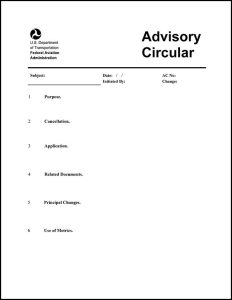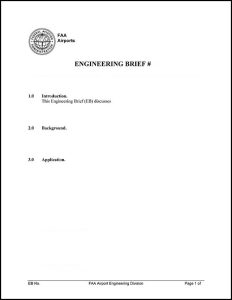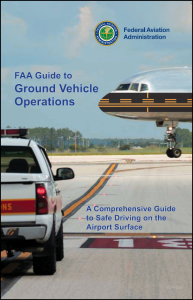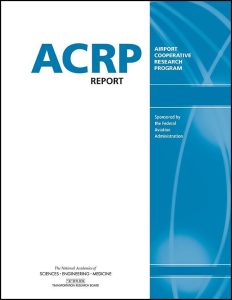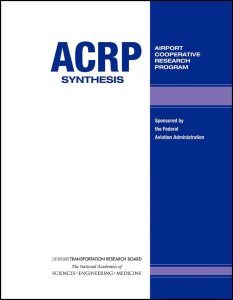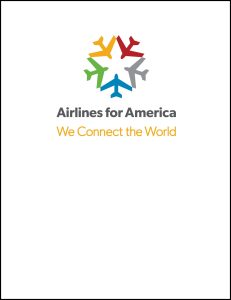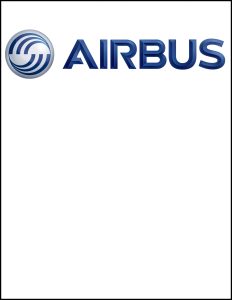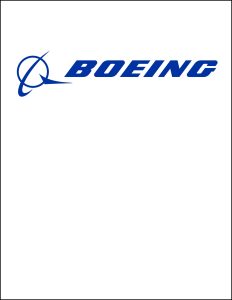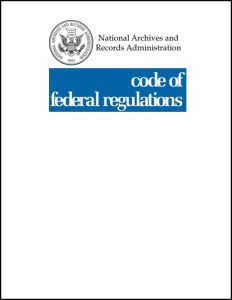To narrow the library of airside resources, use the filter boxes or airport map below or search box above.
Click an item below to expand.
Resources Matching Your Search
2022
This advisory circular (AC) contains the FAA standards and recommendations for airport design. The AC contains the following chapters: (1) Introduction, (2) Design Principles, (3) Runway Design, (4) Taxiway and Taxilane Design, (5) Aprons, and (6) Airfield Systems and Facilities. It also contains the following appendices: (A) Aircraft Characteristics, (B) Wind Analysis, (C) Jet Blast and Propeller Wash, (D) End-Around Taxiway Visual Screens, (E) General Aviation Facilities, (F) Compass Calibration Pad Survey, (G) Runway Design Standards Table, (H) Declared Distances, (I) Runway Additional Information, (J) Taxiway Additional Information, (K) Instrument Flight Procedures, (L) Approach and Departure Reference Codes, (M) Differences in Airport Design Standards and Relationship of Aircraft Characteristics to Design Components, (N) Acronyms, and (O) Index.
2017
This advisory circular (AC) establishes a common, uniform definition of critical aircraft for all deliberations of the FAA Office of Airports, inclusive of planning and environmental, design and engineering, and financial decision-making regarding airport development.
2020
This advisory circular (AC) contains FAA standards for the siting and installation of signs on airport runways and taxiways. Airport sign systems provide visual cues to pilots and vehicle operators, and enhance safe and efficient movement within the airfield. Elevated signs protect aeronautical surfaces and convey ground navigation information that enhances situational awareness when maneuvering on the airfield. The standards of this AC establish uniformity of sign systems throughout the National Airspace System (NAS) for consistent application and interpretation.
2020
This advisory circular (AC) contains FAA standards for markings used on airport runways, taxiways, and aprons. The runway markings addressed include landing designator, centerline, threshold, aiming point, touchdown zone, edge, threshold bar, displaced threshold, hold position, chevrons for blast pads, stopways, engineered material arresting system (EMAS), and shoulder markings.
2018
This advisory circular (AC) provides guidance and recommendations on the installation of airport visual aids, including runway and taxiway edge lighting systems, runway centerline and touchdown lighting systems, taxiway lighting systems, land and hold short lighting systems, rotating beacons, wind cones, obstruction lights, MALSF, ODALS, REILs and PAPIs.
2018
The standard specifications contained in this advisory circular (AC) relate to materials and methods used for construction on airports. Items covered in this AC include general provisions, earthwork, flexible base courses, rigid base courses, flexible surface courses, rigid pavement, fencing, drainage, turf, and lighting installation.
2012
Engineering Brief (EB) 89 provides clarification for taxiway designation convention standards contained in FAA Advisory Circular (AC) 150/5340-18F: Standards for Airport Sign Systems. First, on February 9, 2011, the Office of Airport Safety and Standards distributed a memorandum entitled "Taxiway Naming Conventions" that provided additional information and clarification on taxiway designation convention. Second, a recommendation posted on the FAA Idea Hub, Idea 2320, "Naming airport ramps and aprons," raised concerns about taxiways that have the same names as airport ramps and aprons, as these taxiways have the potential to cause communication problems between pilots and air traffic controllers.
2020
This document provides a comprehensive guide to safe driving on the airport surface. It was created for drivers of tugs, fuel trucks, baggage carts, or other airport vehicles. It focuses on five areas—airport basics; airfield signs, markings and lighting; towered airports; non-towered airports; and aviation phraseology.
2010
ACRP Report 38 provides a comprehensive description of the regulations, standards, evaluation criteria, and processes designed to protect the airspace surrounding airports. Aviation practitioners, local planning and zoning agencies, and developers need to understand and apply the appropriate airspace design and evaluation criteria to ensure a safe operating environment for aircraft as well as to maintain airport operational flexibility and reliability, without unduly restricting desirable building development and attendant economic growth in the surrounding community.
2019
ACRP Research Report 192 is designed to assist airports that are considering self-providing fueling services or currently providing them directly to their customers. The report includes a methodology to help evaluate whether an airport should or should not provide fuel service, a checklist of action items required for providing fuel service, and a sample request for proposals to solicit bids from fuel suppliers. The report also addresses a wide range of topics, including feasibility evaluations for new or improved fueling facilities, fuel pricing and marketing strategies, and organizational considerations when starting or expanding a fueling service.
2019
ACRP Research Report 195 is designed to assist airport operators in developing and implementing an obstruction management program to protect the airport airspace from encroachment by tall objects. The report will help airport staff develop an obstruction management plan by understanding the regulatory environment, identifying obstructions, and developing a strategy for communication with surrounding communities that will ensure airport involvement in any development issues that could result in an obstruction around the airport. The report is supplemented by ACRP WebResource 7: Best Practices for Airport Obstruction Management Library, which provides reference documents, model documents, and presentation materials for obstruction management outreach. A methodology for creating a composite map of all applicable airspace surfaces as well as examples of interactive airspace composite surface maps for small and large airports are also provided.
2007
ACRP Synthesis 2 examines how airport forecasts are used and identifies common aviation metrics, aviation data sources, issues in data collection and preparation, and special data issues at non-towered airports. The report also explores available forecasting methods, including the primary statistical methods, market share analysis, econometric modeling, and time series modeling. In addition, the report reviews forecast uncertainty, accuracy, issues of optimism bias, and options for resolving differences when multiple forecasts are available.
2017
Although numerous standards and recommended practices for pedestrian and aircraft ground movement have been developed over time, only limited guidance is available regarding ground support equipment movement, parking on the ramp, and aircraft engine intake hazard zones. The document is offered for free through the A4A website and is emailed for download after a no-cost purchase process.
2021
This webpage includes planning manuals by the aircraft manufacturer that provide, in an industry-standardized format, airplane characteristics data for general airport planning. Sections within each document include general dimensions of the aircraft, as well as the necessary information for ramp, servicing operations, or maintenance preparations.
2021
The documents in this website provide, in an industry-standardized format, airplane characteristics data for general airport planning. Sections within each document include airplane description, airplane performance, ground maneuvering, terminal servicing, operating conditions, and pavement data.
2021
This resource is a webpage that provides information on the Electronic Code of Federal Regulations (e-CFR) Title 14, Chapter I, Subchapter G, Part 139, which contains guidance on certification, airport certification manual, and operations.
2021
This resource is a webpage that provides information on the Electronic Code of Federal Regulations (e-CFR) Title 14, Chapter I, Subchapter I, Part 150, which contains guidance on Part 150: Airport Noise Compatibility Planning including general provisions, development of noise exposure maps and noise compatibility programs, and evaluation and determinations of effects of noise compatibility programs.
2021
This resource is a webpage that provides information on the Electronic Code of Federal Regulations (e-CFR) Title 14, Chapter I, Subchapter E, Part 77, which contains guidance on the safe and efficient use as well as the preservation of the navigable airspace.
2021
This resource is a webpage that provides information on the Electronic Code of Federal Regulations (e-CFR) Title 19, Chapter I, Part 122, which address air commerce regulations. Subpart B addresses the various classes of international airports.
2021
This resource is a webpage that provides information on the Electronic Code of Federal Regulations (e-CFR) Title 49, Subtitle B, Chapter XII, Subchapter B, Part 1520, which governs the maintenance, safeguarding, and disclosure of records and information that TSA has determined to be Sensitive Security Information, as defined in §1520.5.
